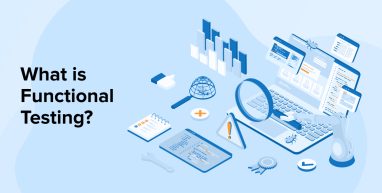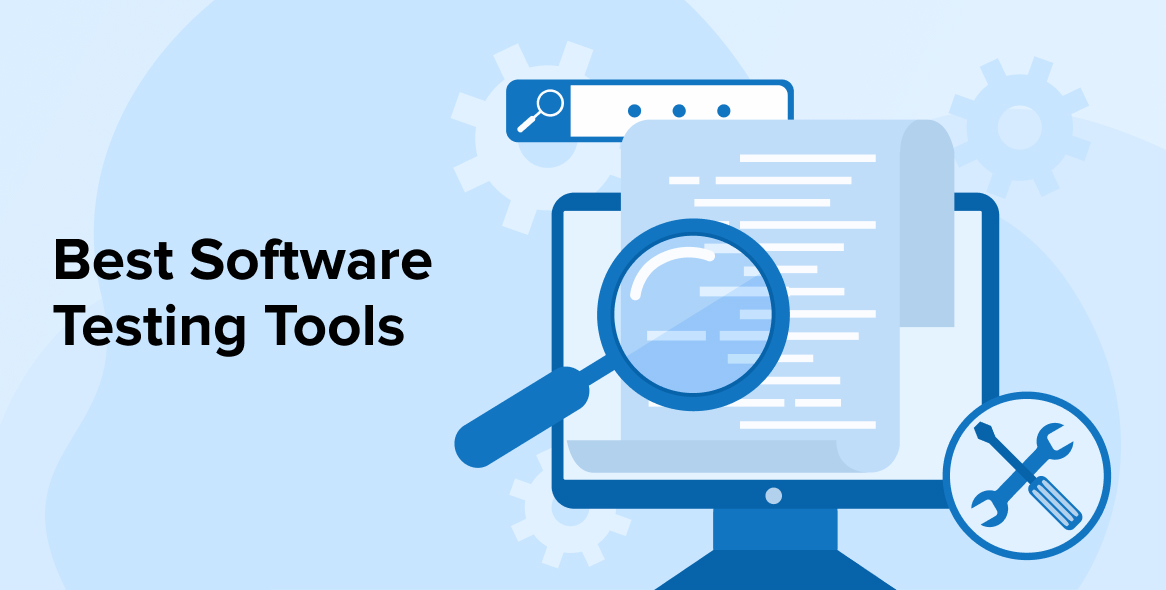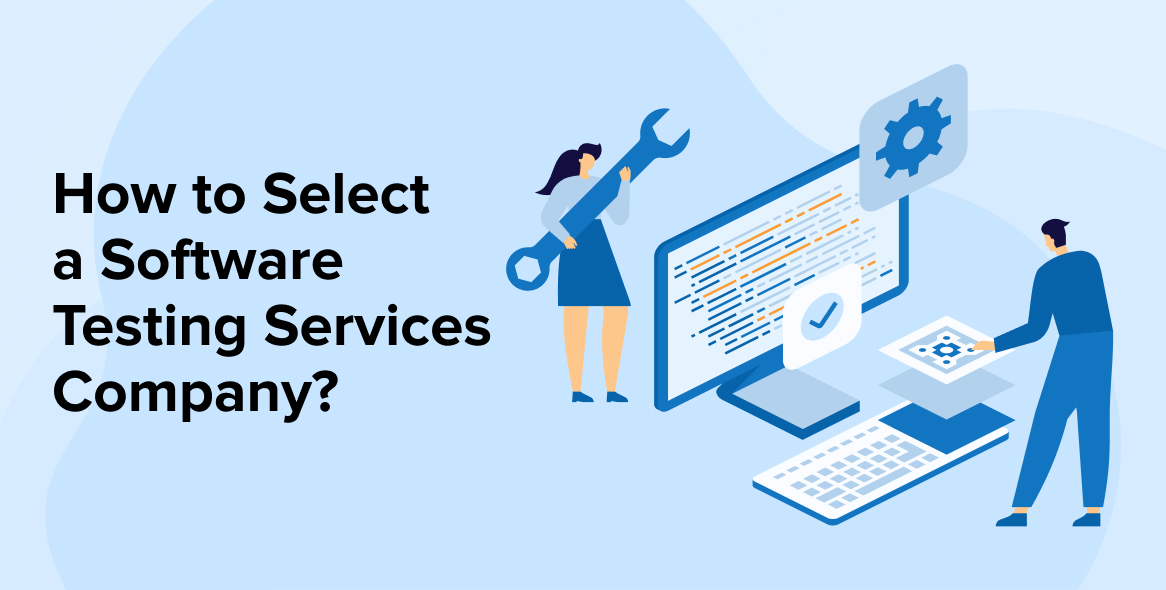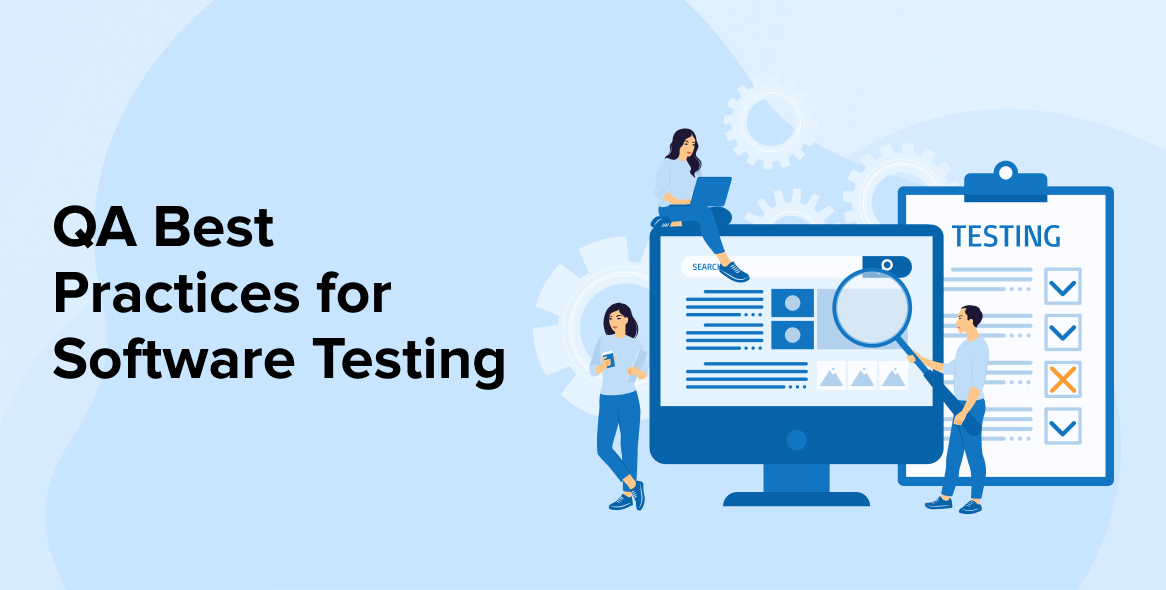
Software development involves more than simply creating the software aligning with the project requirements. As a developer, you cannot just build the product and hand it over to the users for their use. First of all, you need to check whether the developed software meets all the functional requirements. After you are confident about the product’s desired behavior, it can be deployed for the intended users. To fulfill this objective, a software testing company plays a crucial role. Generally, software testing is about functional testing. The field of functional testing is vast. It includes different forms of testing that are essential to the quality assurance process.
In this functional testing blog post, we’ll explore functional testing’s benefits, types, processes, examples, tools, limitations, and, last but not least, best practices. Let’s start now.
1. What is Functional Testing?
Functional testing is a software testing process in which the functionality and features of an application are thoroughly checked against the intended requirements set by developers and end users. You can perform both manual and automated functional testing. The process involves evaluating user interactions, data manipulation, input and output from the software, database, APIs, client/server communication, security, and the application’s behavior under various scenarios and conditions.
The functional testing process uses a black-box testing approach. The software tester checks the application by providing different inputs. The results are then compared to the expected outcomes. Here, there’s no need to know the application’s source code or internal architecture. They only test the program, not the system. The goal is to meet the primary expectations of the end user and to achieve the business objectives.
Here is what a Quora user says about functional testing.

1.1 Benefits of Functional Testing
Functional testing has many advantages. It’s the most fundamental type of software testing technique for improving and maintaining software quality and reliability. Below are some of the key benefits of functional testing:
- Reduces Maintenance Costs: Early detection and resolution of software bugs can save costs that can be incurred in later development stages or after the application’s deployment.
- Increase in test Coverage: Functional tests cover all the aspects of the application, thoroughly validating its features and components.
- Customer Satisfaction: Proper attention is given to ensuring that the application works properly from the user’s perspective, which enhances user experience and satisfaction.
- Facilitates Regression Testing: When you make any modifications or updates, you should rerun functional tests to ensure that the existing features are functioning accurately.
- Requirement Compliance: It verifies that the software meets the intended requirements and functions correctly, reducing the chances of missing any functionalities.
1.2 Types of Functional Testing
As mentioned above, functional testing includes multiple checks to ensure through software evaluation, validating various aspects of the application during user acceptance testing(UAT). The following are the major types of functional testing.
1. Unit Testing
Unit testing checks the individual components or units of an application in isolation during the initial stages of development. These units can be a single function, method, or class, each having its specific roles. Each unit test consists of one or more test cases that specify input data, expected outcomes, and the conditions under which the unit is expected to operate. Techniques like branch coverage, statement coverage, boundary value analysis, and decision coverage are used in unit testing.
Here is what a Quora user says about unit testing.

2. Smoke Testing
Smoke testing focuses on verifying the major functionalities of a software application rather than examining each feature in detail. It’s performed as soon as the new software build is released to check the application’s stability before conducting more exhaustive testing. Due to this characteristic, smoke testing is also called “build verification testing” or “confidence testing.”
3. Integration Testing
Integration testing checks the functionality of integrated untested components or units of an application. The designed test cases check the communication and data flow between software modules, components, or entire systems. This type of testing follows unit testing and precedes system testing. There are generally two approaches to integration testing: big bang integration and incremental integration. It helps to identify problems related to data formats, communication protocols, and mismatched expectations between integrated modules.
Here is what a Twitter user says about integration testing.
Integration tests do not test business rules. Those rules have already beeen tested, once by programmer (unit) tests, and again by customer (acceptance) tests.
— Uncle Bob Martin (@unclebobmartin) January 4, 2019
Integration tests test the plumbing and choreography of the components.
4. User Acceptance Testing
User acceptance testing (UAT) involves validating software by end users or stakeholders. It’s the final stage of usability testing before it is deployed into the real world. The goal is to check the application’s behavior in real-world scenarios from the end user’s perspective. There are two types of user acceptance testing: alpha testing, which is administered by internal staff, and beta testing, which is carried out by a selected group of external users in a real-world environment.
5. System Testing
System testing is a black box testing technique performed after integration testing and before user acceptance testing (UAT). It examines the entire system including its functionality, performance, security, usability, and compatibility. The testing environment approaches the existing production environment to simulate real-world conditions. System testing ensures that end-to-end workflows and processes within the application work seamlessly and correctly.
2. Functional Testing Process
The functional testing process consists of the following key steps:
2.1 Identify the Testing Goals
You must analyze the features and functionalities you want in your application based on the project requirements using the provided documentation (e.g., Business Requirements Document (BRD), and Functional Requirements Specification (FRS)). Consider end users and their expectations. Then, decide on the types of functional testing needed such as unit testing, smoke testing, sanity testing, and regression testing.
2.2 Test Planning
Once you’re aware of the test objectives, it’s time to plan the test strategy. Determine which features and functionalities you want to test, the required number of testers for the team, the necessary resources, test environment needs, map test scenarios to requirements, test case preparation, and execution timelines; etc.
2.3 Create Test Scenarios
Create detailed test scenarios that cover all functional requirements. Each test scenario includes the scenario ID, description/ title of the scenario, preconditions, test steps, inputs, expected results, and post-conditions.
2.4 Setup Test Environment and Create Test Data
You need to configure a proper test environment that closely resembles the production environment. Set up the network, hardware, and software based on the application to be tested to identify potential operating flaws. Ensure that the test environment is compatible with multiple devices, operating systems, and browsers.
Testers ensure that they test all possible scenarios to improve overall test coverage. They provide the application with input, either manually or through automation tools, and then compare the generated output with the expected outcome.
2.5 Design Test Cases
Develop test cases for each test scenario that describe a specific set of actions to be performed to verify a particular aspect of an application. Each test case includes the test case ID, description/ title of the scenario, preconditions, test steps, inputs, expected results, and post conditions.
2.6 Execute Tests
Execute the test cases as per the predefined test plan. Document the outcomes and note any discrepancies between expected and actual results.
4.7 Deliberate On, Track, and Resolve Defects
If you come across any divergence from the expected outcomes, you should document them with detailed information in a formal tracking system. You must classify the irregularity based on severity and impact. Try to resolve the issue by making appropriate changes in the application and then re-execute the test cases.
2.8 Add Test Closure
After completion of all the above steps, prepare a summary of the tests performed during the entire software testing cycle. Test closure marks the end of the testing process. It is a detailed document describing the testing activities, bugs detected, screenshots of query results, statuses of the defects whether resolved or not, suggestions on improvements, etc.
3. Examples of Functional Testing
Below mentioned are the most common examples of functional testing.
- User Login and Authentication Testing: You can create a test case in which you enter the correct username and password to log in. Then, check if the system grants access. Afterward, input an invalid password and verify whether the system denies access.
- Form Submission: Fill out the form with all the necessary valid details and submit it. Check if you receive a message like the form was submitted successfully. Try leaving mandatory fields blank. You must receive error messages for missing fields.
- Shopping Cart Functionality in eCommerce Websites: Add items to the shopping cart and verify if the total price is correct. Increase or decrease the quantity of any item or remove or add some items. Now check whether the price updates accordingly.
- Payment Gateway Integration: Figure out the items you wish to buy and move forward to checkout. Choose any payment method like paying through a debit card. Enter the correct card details and click on submit. Check for payment success and order confirmation message.
- Searching in an Online Store: Navigate to the search bar in an online store and search for your preferred product. See if relevant results pop up. Try with partial or incorrect product names and check the search results.
4. Functional Testing Tools
We know that we can automate functional testing using various functional testing tools available in the market. We will now look at some of the most popular functional testing automation tools.
4.1 Selenium
Selenium is the most popular browser automation tool for web applications and provides flexibility to developers by allowing them to create reusable test scripts in multiple programming languages such as Java, Python, and C#. It can smoothly scale to include several test cases, test scenarios, and user interactions. It can be used for functional testing of web applications, including validating UI components, workflows, and form submissions.
4.2 QTP
QuickTest Professional/Unified Functional Testing automates testing for web, desktop, and mobile applications. It is one of the most advanced tools for regression and functional testing and it supports popular automation frameworks like keyword-driven testing, modular testing, and data-driven testing. It can be integrated with test management tools like Quality Center, Test Director, and Winrunner
4.3 Katalon Studio
Katalon Studio is an all-in-one automation testing tool to test web, mobile, API, and desktop applications within a single platform. It gives the flexibility to programmers to create test cases using built-in keywords reducing the need to write extensive codes and eliminate errors.
You can schedule test cases and bundle them for execution using the Katalon Runtime Engine (KRE). It supports wide integrations with CI/CD tools like Bamboo and Jenkins, ALM systems such as Jira and qTest, and version control systems like Git and GitHub, etc. You can use C#, Java, TypeScript, and Python languages to create test cases and get detailed reports and analytics on their execution.
4.4 Appium
Appium is an open-source mobile testing automation framework for testing native, mobile web, and hybrid applications. It consists of three components including the Appium client containing configuration details, Nodejs-based HTTP Appium server, and end devices such as emulators and simulators connected to the Appiyum server. It can be used to test applications running on different mobile platforms such as Android, iOS, and Windows.
Appium allows users to write automation scripts in PHP, Java, Pearl, and Python languages. It’s easy to use, supports integration with Selenium, Jenkins, and TestNG; and consists of extensive documentation and community support.
4.5 Postman
Postman is a highly popular API-testing software application used to build, test, design, modify, and document APIs. The intuitive and user-friendly visual editor simplifies the API designing and debugging process even for non-technical users by facilitating easy setup and configuration.
You can test the functionality, performance, security, etc. of APIs with this tool. Postman integrates seamlessly with CI/CD pipelines during deployment, reducing the chances of bugs emerging in production environments.
4.6 SoapUI
SoapUI is a popular and open-source testing tool used for testing APIs, including both REST and SOAP web services. It supports various protocols such as HTTP, SOAP, and JDBC. SoapUI allows you to create and execute automated functional tests for APIs, ensuring that they return the correct data and handle requests as expected. It facilitates collaboration between testing and development teams.
6.7 TestComplete
TestComplete provides script-based and scriptless functional testing capabilities for creating automated user interface tests for web, desktop, and mobile applications. The test creation can be in JavaScript, Python, VBScript, JScript, and C#. TestComplete perfectly integrates with frameworks like Selenium WebDriver for extensive web testing.
5. Functional Testing vs Non-Functional Testing
| Parameters | Functional Testing | Non-Functional Testing |
|---|---|---|
| Goal | Manual or automated testing using automation tools, such as Selenium, TestComplete, or QTP. | Tests the software’s behavior or non-functional aspects such as performance, security, reliability, and scalability. |
| Scope | Tests particular functions or properties in isolation. | Non-functional tests pay attention to aspects beyond functionality. |
| Testing Types | Unit testing, integration testing, smoke testing, user acceptance testing, regression testing, etc. | Performance metrics, and security vulnerability reports. |
| Timing | In the early stages of SDLC. | Non-functional testing is performed in the later stages after functional testing. |
| Output | Pass/Fail status of specific functions. | Performance metrics, security vulnerability reports. |
| Methodology | Manual or automated testing using automation tools, for example, Selenium, TestComplete, or QTP. | Automated tests are mainly performed using JMeter, LoadRunner, SoapUI, or Burp Suite. |
| Test Cases | Requirements-based test cases derived from functional specifications or user stories. | Test cases are based on quality attributes like performance benchmarks, security policies, or industry standards. |
6. Limitations of Functional Testing
Functional testing is highly important to check the preparedness of an application for real-time usage. However, it has some limitations and disadvantages.
- Test Data Limitations: Functional tests depend on predefined test data which can result in undetected software bugs that only emerge with specific or rare data inputs.
- Time-Consuming: Creating, maintaining, and executing automated test cases can be time-consuming, especially for large and complex applications.
- No Performance Guarantee: You cannot measure an application’s performance in terms of speed, responsiveness, or resource usage. A feature working correctly in isolation may fail in real-world conditions.
- Incomplete Coverage: Functional testing is based on specified requirements, but what if some of the requirements are incomplete or missed? It can lead to test failures.
- Complexity with Larger Systems: In large systems with multiple integrated modules, testing individual functionalities can become complex and difficult to manage.
7. Best Practices for Functional Testing
After understanding the necessity of conducting functional tests, let’s take a look at the functional testing best practices. You can consider these in your testing strategy and make the most of it.
- Build Precise Test Cases: Develop structured and detailed test cases covering all possible scenarios according to the functional requirements.
- Prioritize Test Execution: It’s not feasible to test every functionality of the software, especially if it’s large and complex. Time and resources are limited. So, a developer must smartly prioritize the execution of test cases.
- Test Early: To perform functional testing in the early stages of software development to catch and resolve the bugs as early as possible and prevent future expenses and effort.
- Perform Regression Testing: After any system update or bug fix, run regression tests to ensure that untouched features function exactly as they did before modification.
8. Final Thoughts
In today’s world of artificial intelligence, new software is released every day. Hence, ensuring that the developed software performs according to the anticipated behavior becomes necessary. Functional testing techniques ensure that your application works according to the functional requirements to a large extent. This makes functional testing important. Now, choosing the proper approach requires a thorough test plan. You need to analyze carefully the areas for manual testing and automation testing. If you choose to perform automated functional testing you require a dedicated automation team to create automated tests and perform automation tasks.
The above functional testing blog will surely help you in your software testing or development career regardless of whether you are a beginner or an experienced professional. So go through this blog carefully to reduce human error and follow the best of many functional testing techniques.
FAQs
What is Functional Testing vs UAT?
Functional Testing confirms that the software operates correctly according to the specified requirements, focusing on individual features and technical aspects. Actual customers or stakeholders conduct User Acceptance Testing (UAT). They aim to ensure that the application meets all business requirements and performs well in real-world scenarios before deployment.
Is Functional and UI (User Interface) Testing the Same?
No, Functional Testing and UI Testing are different testing forms. Functional testing checks whether the software’s features work according to the specified requirements, focusing on the system’s behavior and outputs. However, UI testing (user interface testing) particularly evaluates the graphical interface, ensuring that buttons, forms, layouts, and other visual elements function correctly and ultimately give a good user experience. While UI testing is part of functional testing, it focuses solely on the look and feel of the interface.






Comments
Leave a message...